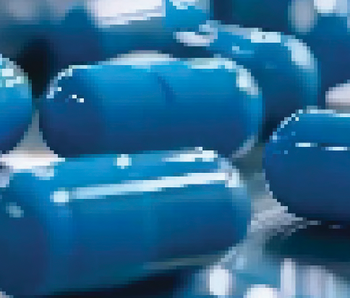
- October 2019
- Volume 4
- Issue 5
Investigational Treatments for Clostridioides difficile Infection

The high recurrence rates of Clostridioides difficile infection highlight the need for novel agents with unique mechanisms of action for treating the infection.
Clostridioides difficile infection (CDI), the most common cause of nosocomial diarrhea worldwide, carries a mortality rate of ~40%.1-3 Currently approved CDI agents (vancomycin, fidaxomicin) are associated with high recurrence rates of 20%-30%, leading to increased readmissions (75.2% vs 46.9%, CDI infected vs noninfected, respec­tively).1,4 The 2018 Infectious Diseases Society of America (IDSA) CDI guide­lines devalued the use of metronidazole as the primary agent to a secondary role, as it was inferior to vancomycin for mild and moderate disease, with increased recurrence rates. Meanwhile, fidaxomicin was raised to a first-line option.5 For second or subsequent recurrences, the guidelines also recommend fecal microbiota transplant (FMT).
Fidaxomicin has demonstrated several meaningful differ­ences compared with currently available CDI treatment options. Animals studies have revealed that fidaxomicin exposure led to minimal microbiota disruption and did not promote colonization by vancomycin-resistant enterococci and Klebsiella pneumoniae, whereas exposure to vancomycin did promote colonization by these bacteria.6,7 Host micro­biome preservation is thought to be the primary driver of fidaxomicin’s reduced CDI recurrence rates compared with vancomycin.8,9 Albeit recurrence rates are less than vanco­mycin, they are still at ~20%. Fidaxomicin’s high price tag compared with that of vancomycin and conflicting data from studies on its overall cost-effectiveness have resulted in relatively poor clinical uptake.10 For patients with prior vancomycin failure, fidaxomicin is recommended rather than administering the same failed treatment—primarily to save drug costs all while increasing overall health care costs and decreasing patients’ quality of life.
The IDSA treatment guidelines recommend FMT for recurrent CDI. Based on the principle that restoration of a healthy gut microbiota will reduce susceptibility of a patient to CDI, cure rates of >80% have been reported in most clinical trials.11,12 FMT can be administrated via oral capsules, lower gastrointestinal (GI) tract proce­dure (colonoscopy, retention enema), or upper GI tract procedure (nasojejunal/nasoduodenal tube). The US Food and Drug Administration (FDA) has not approved FMT but has allowed its use as an investigational drug. Major concerns with FMT are the lack of long-term studies, the risk of transferring infectious pathogens from the donor to the recipient, and the development of immune-medi­ated diseases such as irritable bowel disease. Additionally, the FDA issued a safety alert in June 2019 after a patient died and another suffered an invasive infection, with both illnesses caused by extended-spectrum β-lactamase— producing Escherichia coli post-FMT from the same donor.
We recommend FMT as last resort, with screening of the donor’s stool as a prerequisite.
Clearly, the currently approved CDI agents are not optimal. Improved therapeutic alternatives with a signif­icant protective and restorative effect on the intestinal microbiome are needed for CDI treatment to ultimately lead to better efficacy and lower recurrence rates. This article will provide a brief review of select drugs in the pipeline for CDI and discuss lessons learned from prior failed clinical trials.
NOVEL AGENTS IN LATER-STAGE DEVELOPMENT
Ribaxamase (SYN-004) offers a unique approach to the prevention of CDI, namely protection of patients’ natural microbiome. Preserving the normal microbiome is key to preventing CDI, as disruption of the microbiota is at the core of CDI pathogenesis. Upon microbiome disruption, patients lose their protective barrier, and CDI can develop quickly with exposure to spores. The most commonly associated factor of microbiome disruption is antibi­otic use, with decreases in the gut microbiota diversity detectable within days of antibiotic use. Ribaxamase is an orally ingested enteric-coated enzyme that destroys select β-lactams, including penicillins and cephalosporins, in the distal intestine. Antibiotic destruction in the intestinal space allows for protection of the host microbiome and reduces CDI risk. Two open-label, randomized phase 2a studies of intravenous (IV) ceftriaxone alone or with oral ribaxamase enrolled subjects with functioning ileostomies demonstrated that ribaxamase was well tolerated and fully degraded ceftriaxone to below the level of detection in the chime, with no effect on ceftriaxone plasma pharmacoki­netics.13 A phase 3 study is expected to start the second half of 2019 to assess the efficacy and safety of ribaxamase in a broader patient population by including additional IV β-lactams with ceftriaxone and by enrolling patients with a variety of underlying infections.14 Pending phase 3 trial results, ribaxamase could be the first drug on the market for CDI prevention, making it one of the most novel drugs in the pipeline for CDI. Protecting the gut microbiota from the damaging consequences of antibiotics initially, rather than trying to restore the microbiome after the damage has already been done, is game-changing in the CDI paradigm.
Ridinilazole ( formerly SMT19969) is a nonabsorbable antibacterial with a unique mechanism of action of elon­gating the C difficile cell and inhibiting sporulation.15 In a phase 2 trial, ridinilazole was noninferior to vancomycin (15% noninferiority margin; P =.0004), with sustained clin­ical response rates of 24/36 (66.7%) and 14/33 (42.4%) for patients on ridinilazole and vancomycin, respectively.16 Based on these results, investigators are conducting phase 3 studies to evaluate ridinilazole 200 mg orally twice daily compared with standard-dose vancomycin.
NOVEL AGENTS IN EARLY DEVELOPMENT
DS-2969b is a novel GyrB inhibitor.17 A low propensity for in vitro resistance development and limited impact on the intestinal microbiome were noted in studies.18,19,20 With the phase 1a studies just recently published, whether the company will decide to pursue phase 2 trials is unclear, but a drug with low propensity for resistance development and low impact on microbiome would be a critical step forward and would be expected to improve CDI recurrence and, thereby, reduce readmissions and overall cost to health care. We are looking forward to future similar drug developments.
Compared with the currently available CDI treatments, the novel drugs mentioned in this article may offer various advan­tages. However, because these new compounds are in early development, limited conclusions can be drawn until phase 3 clinical trials are completed and analyzed. Unfortunately, although current options for CDI drug development are exciting, we are simultaneously seeing major failures in the clinical trial development and management of CDI. The recent clinical failures of cadazolid and surotomycin may be the product of poor study design, not poor drug effectiveness.
LEARNING FROM CADAZOLID AND SUROTOMYCIN
Cadazolid and surotomycin are 2 late-stage agents for CDI that recently failed meeting their clinical trial end points. Close analysis of these clinical trials suggests that poor end point definitions or poor study design may have resulted in trial failure—a costly mistake for a therapeutic area with significant medical need.
Cadazolid (ACT-179811) is a nonabsorbable, narrow-spec­trum agent. A phase 2 multicenter, randomized, controlled study of various cadazolid dosages compared with those of vancomycin did not meet its end point because of strict definitions of diarrhea and cure.21,22 The clinical cure rates were not significantly higher than the preset 75% cure rate in any cadazolid group (68.4%-80.0%) or in the vancomycin group (68.2%). This was the result of the stringent criteria (≤2 semiformed or formed stools [and no unformed bowel movements [UMBs]] for 2 consecu­tive days) that were selected for the definition of diarrhea resolution. Patients were considered clinical failures when the study definition of clinical cure based on fecal output was not met. However, when modified criteria comparable to those used in the phase 3 studies of fidaxomicin (≤3 UMBs for 2 consecutive days) were applied,9,23 the response to vanco­mycin in the present study was comparable to that in the recently completed phase 3 trials, and the modified clinical cure rates for cadazolid (84.2%-94.1%) were comparable to those for vancomycin (86.4%). Nevertheless, because the phase 2 trial results indicated that cadazolid demonstrated supe­riority to vancomycin for recurrence and sustained clinical cure, the drug was moved to phase 3 trials.24 Unfortunately, cadazolid failed to meet the primary end point in one of the phase 3 trials (IMPACT-2). In the phase 3 trials, the primary end point was clinical cure, defined as resolution of diar­rhea (≤3 UMBs/day for at least 2 consecutive days) on study treatment and maintained for 2 days after the end of therapy with no further CDI therapy required. This definition may be too strict because a patient’s status change from 16 UBMs to 4 UBMs would be considered a clinical failure based on IMPACT-1 and IMPACT-2 definitions. The observation that vancomycin, a current clinical standard of care, failed to meet the primary end point in the phase 2 studies and that cadazolid failed to meet the primary end point in IMPACT-2 strongly suggests that the study definition of resolution of diarrhea was too strict and could potentially be changed to ≤3 UBMs daily, or a 75% decrease in stool volume for at least 2 consecutive days.
Surotomycin is a minimally absorbed lipopeptide agent with a microbiome-sparing approach. In the surotomycin phase 2 trials, the recurrence rate was 17.2% versus 35.6%, favoring high-dose surotomycin compared with vancomycin, respectively (P = .035).25 The primary end point was resolu­tion of diarrhea sustained through 2 days after CDI therapy ended and no need for additional antibiotics. Again, phase 3 clinical trials did not meet the primary end point of clin­ical cure. Clinical trial data suggested the use of surotomycin over vancomycin may have some clinical benefits, including decreased recurrence rates, but again, clinical trial design challenges likely resulted in type II error, in which a poten­tially valuable treatment option is lost when true benefits may have been seen. End point definitions and patient selection regarding testing methods used to establish both diagnosis and that of relapse/failure (polymerase chain reaction vs enzyme immunoassay vs cytotoxic assay) potentially contributed to the surotomycin phase 3 failure. The phase 2 and 3 studies had trial design differences. The inclusion criteria differed (phase 2 trial: ≥4 UBMs were required for inclusion; phase 3 trial: ≥3 UBMs), the definition of cure differed (phase 2 trial: defined as <4 UBMs per 24-hour period for at least 2 consecutive days; phase 3 trial: ≤2 UBMs per 24-hour period for at least 2 consecutive days), and the follow-up period differed, potentially leading to distinct sustained clinical response rates (phase 2 trial: 28 days; phase 3 trial: 30-40 days). In both the phase 2 and phase 3 surotomycin trials, CDI diagnosis required only 1 toxin-positive result. The most current CDI diagnosis recom­mendations include a 2-step procedure.
Critical clinical trial lessons must be learned from future studies, or other valuable treatment options will be lost. We also strongly urge clinicians to consider preventive care rather than chasing CDI after it already occurs, as limiting antibiotic use and preserving the microbiome is crucial to decreasing the public health threat of CDI.
Kullar is an infectious diseases pharmacist investigator and an epidemiologist who has been actively involved in leading antimicrobial stewardship initiatives worldwide for more than 10 years. *She is an active member of the Society for Infectious Diseases Pharmacists.Tran earned her doctor of pharmacy degree from the Philadelphia College of Pharmacy at the University of the Sciences in Philadelphia, Pennsylvania. She completed a PGY-1 residency at Indiana University Health in Indianapolis, Indiana. Following her residency, she moved to California and established the pharmacy practice in the emergency department at Providence Saint John’s Health Center in Santa Monica, California. Goldstein is a clinical professor of medicine at the David Geffen School of Medicine at the University of California, Los Angeles, and director of the R. M. Alden Research Laboratory. He is in private practice in Santa Monica, California.
References:
1. Olsen MA, Yan Y, Reske KA, Zilberberg MD, Dubberke ER. Recurrent Clostridium difficile infection is associated with increased mortality. Clin Microbiol Infect. 2015 Feb;21(2):164-70. doi: 10.1016/j.cmi.2014.08.017. Epub 2014 Oct 12.
2. Lessa FC, Mu Y, Bamberg WM, et al. Burden of Clostridium difficile infection in the United States. N Engl J Med. 2015 Feb 26;372(9):825-34. doi: 10.1056/NEJMoa1408913.
3. Zhang S, Palazuelos-Munoz S, Balsells EM, Nair H, Chit A, Kyaw MH. Cost of hospital management of Clostridium difficile infection in United States-a meta-analysis and modelling study. BMC Infect Dis. 2016 Aug 25;16(1):447. doi: 10.1186/s12879-016-1786-6.
4. Bakken JS, Polgreen PM, Beekmann SE, Riedo FX, Streit JA. Treatment approaches including fecal microbiota transplantation for recurrent Clostridium difficile infection (RCDI) among infectious disease physicians. Anaerobe. 2013 Dec;24:20-4. doi: 10.1016/j.anaerobe.2013.08.007. Epub 2013 Sep 4.
5. Johnson S, Louie TJ, Gerding DN, et al. Vancomycin, metronidazole, or tolevamer for Clostridium difficile infection: results from two multinational, randomized, controlled trials. Clin Infect Dis. 2014 Aug 1;59(3):345-54. doi: 10.1093/cid/ciu313. Epub 2014 May 5.
6. Deshpande A, Hurless K, Cadnum JL, et al. Effect of Fidaxomicin versus Vancomycin on Susceptibility to Intestinal Colonization with Vancomycin-Resistant Enterococci and Klebsiella pneumoniae in Mice. Antimicrob Agents Chemother. 2016 Jun 20;60(7):3988-93. doi: 10.1128/AAC.02590-15. Print 2016 Jul.
7. Nerandzic MM, Mullane K, Miller MA, Babakhani F, Donskey CJ. Reduced acquisition and overgrowth of vancomycin-resistant enterococci and Candida species in patients treated with fidaxomicin versus vancomycin for Clostridium difficile infection. Clin Infect Dis. 2012 Aug;55 Suppl 2:S121-6. doi: 10.1093/cid/cis440.
8. Louie TJ, Cannon K, Byrne B, et al. Fidaxomicin preserves the intestinal microbiome during and after treatment of Clostridium difficile infection (CDI) and reduces both toxin reexpression and recurrence of CDI. Clin Infect Dis. 2012 Aug;55 Suppl 2:S132-42. doi: 10.1093/cid/cis338.
9. Louie TJ, Miller MA, Mullane KM, et al. Fidaxomicin versus vancomycin for Clostridium difficile infection. N Engl J Med. 2011 Feb 3;364(5):422-31. doi: 10.1056/NEJMoa0910812.
10. Lam SW, Neuner EA, Fraser TG, Delgado D, Chalfin DB. Cost-effectiveness of three different strategies for the treatment of first recurrent Clostridium difficile infection diagnosed in a community setting. Infect Control Hosp Epidemiol. 2018 Aug;39(8):924-930. doi: 10.1017/ice.2018.139. Epub 2018 Jul 2.
11. Quraishi MN, Widlak M, Bhala N, et al. Systematic review with meta-analysis: the efficacy of faecal microbiota transplantation for the treatment of recurrent and refractory Clostridium difficile infection. Aliment Pharmacol Ther. 2017 Sep;46(5):479-493. doi: 10.1111/apt.14201. Epub 2017 Jul 14.
12. Tariq R, Pardi DS, Bartlett MG, Khanna S. Low Cure Rates in Controlled Trials of Fecal Microbiota Transplantation for Recurrent Clostridium difficile Infection: A Systematic Review and Meta-analysis. Clin Infect Dis. 2019 Apr 8;68(8):1351-1358. doi: 10.1093/cid/ciy721.
13. Kokai-Kun JF, Bristol JA, Setser J, Schlosser M. Nonclinical Safety Assessment of SYN-004: An Oral beta-lactamase for the Protection of the Gut Microbiome From Disruption by Biliary-Excreted, Intravenously Administered Antibiotics. Int J Toxicol. 2016 May;35(3):309-16. doi: 10.1177/1091581815623236. Epub 2015 Dec 23.
14. Synthetic Biologics Announces Positive Outcome of End-of-Phase 2 Meeting with FDA on SYN-004 (ribaxamase) Development: Synthetic Biologics; 2018 updated 2018;Nov 25, 2018 Nov 21, 2018;Nov 21, 2018;Nov 25. Available from:
15. Basseres E, Endres BT, Khaleduzzaman M, et al. Impact on toxin production and cell morphology in Clostridium difficile by ridinilazole (SMT19969), a novel treatment for C difficile infection. J Antimicrob Chemother. 2016 May;71(5):1245-51. doi: 10.1093/jac/dkv498. Epub 2016 Feb 18.
16. Vickers RJ, Tillotson GS, Nathan R, et al. Efficacy and safety of ridinilazole compared with vancomycin for the treatment of Clostridium difficile infection: a phase 2, randomised, double-blind, active-controlled, non-inferiority study. Lancet Infect Dis. 2017 Jul;17(7):735-744. doi: 10.1016/S1473-3099(17)30235-9. Epub 2017 Apr 28.
17. Kumar M, Mathur T, Joshi V, Upadhyay DJ, Inoue SI, Masuda N. Effect of DS-2969b, a novel GyrB inhibitor, on rat and monkey intestinal microbiota. Anaerobe. 2018 Jun;51:120-123. doi: 10.1016/j.anaerobe.2018.04.017. Epub 2018 May 2.
18. Mathur T, Barman TK, Kumar M, et al. In Vitro and In Vivo Activities of DS-2969b, a Novel GyrB Inhibitor, against Clostridium difficile. Antimicrob Agents Chemother. 2018 Mar 27;62(4). pii: e02157-17. doi: 10.1128/AAC.02157-17. Print 2018 Apr.
19. Dennie J, Vandell AG, Inoue S, et al. A Phase I, Single-Ascending-Dose Study in Healthy Subjects to Assess the Safety, Tolerability, Pharmacokinetics, and Pharmacodynamics of DS-2969b, a Novel GyrB Inhibitor. J Clin Pharmacol. 2018 Dec;58(12):1557-1565. doi: 10.1002/jcph.1151. Epub 2018 May 10.
20. Vandell AG, Inoue S, Dennie J, et al. Phase 1 Study To Assess the Safety, Tolerability, Pharmacokinetics, and Pharmacodynamics of Multiple Oral Doses of DS-2969b, a Novel GyrB Inhibitor, in Healthy Subjects. Antimicrob Agents Chemother. 2018 Apr 26;62(5). pii: e02537-17. doi: 10.1128/AAC.02537-17. Print 2018 May.
21. Louie T, Nord CE, Talbot GH, et al. Multicenter, Double-Blind, Randomized, Phase 2 Study Evaluating the Novel Antibiotic Cadazolid in Patients with Clostridium difficile Infection. Antimicrob Agents Chemother. 2015 Oct;59(10):6266-73. doi: 10.1128/AAC.00504-15. Epub 2015 Jul 27.
22. Gerding DN, Hecht DW, Louie T, et al. Susceptibility of Clostridium difficile isolates from a Phase 2 clinical trial of cadazolid and vancomycin in C difficile infection. J Antimicrob Chemother. 2016 Jan;71(1):213-9. doi: 10.1093/jac/dkv300. Epub 2015 Oct 3.
23. Cornely OA, Crook DW, Esposito R, et al. Fidaxomicin versus vancomycin for infection with Clostridium difficile in Europe, Canada, and the USA: a double-blind, non-inferiority, randomised controlled trial. Lancet Infect Dis. 2012 Apr;12(4):281-9. doi: 10.1016/S1473-3099(11)70374-7. Epub 2012 Feb 8.
24. Gerding DN, Cornely OA, Grill S, et al. Cadazolid for the treatment of Clostridium difficile infection: results of two double-blind, placebo-controlled, non-inferiority, randomised phase 3 trials. Lancet Infect Dis. 2019 Mar;19(3):265-274. doi: 10.1016/S1473-3099(18)30614-5. Epub 2019 Jan 29.
25. Daley P, Louie T, Lutz JE, et al. Surotomycin versus vancomycin in adults with Clostridium difficile infection: primary clinical outcomes from the second pivotal, randomized, double-blind, Phase 3 trial. J Antimicrob Chemother. 2017 Dec 1;72(12):3462-3470. doi: 10.1093/jac/dkx299.
Articles in this issue
about 6 years ago
Antibiotic Resistance: Patients Don't Get It, and We Need to Helpabout 6 years ago
Evaluating the Role of New Beta-Lactam Agents for Uncommon PathogensNewsletter
Stay ahead of emerging infectious disease threats with expert insights and breaking research. Subscribe now to get updates delivered straight to your inbox.

















































































































































































































































































